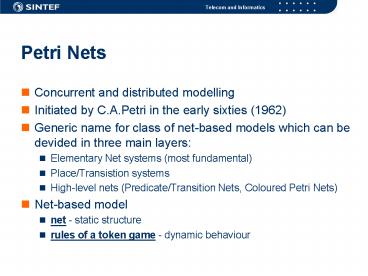Petri Nets - PowerPoint PPT Presentation
1 / 16
Title: Petri Nets
1
Petri Nets
- Concurrent and distributed modelling
- Initiated by C.A.Petri in the early sixties
(1962) - Generic name for class of net-based models which
can be devided in three main layers - Elementary Net systems (most fundamental)
- Place/Transistion systems
- High-level nets (Predicate/Transition Nets,
Coloured Petri Nets) - Net-based model
- net - static structure
- rules of a token game - dynamic behaviour
2
Three layers
3
Static the net
- Build up from places and transitions,
- Arrows between them (never from place-gtplace or
from transition-gttransition)
4
Dynamic the rules of a token game
- Start configuration (Initial Configuration)
- A transition t can fire if all input places of t
contain tokens and all output places of t are
empty
5
Local states and neighbourhood
6
Definition
- A net is triple N ( P, T, F), where
- P and T are finite sets with P ? T ?,
- F ? (P ? T) ? (T ? P),
- for every t ? T there exists p, q ? P such that
(p, t), (t, p) ? F, and - for every t ? T and p, q ? P, if (p, t), (t, p) ?
F, then p ? q.
7
Example
- The net N (P, T, F) with
- P p1, p2,
- T t1,
- F (p1, t1), (t1, p2)
8
Producer - Consumer Problem
c1
p1
producing
emptying
p2
c2
buffer
consuming
filling
9
Mutual Exclusion Problem
A(1)
B(1)
in1
in2
A(2)
B(2)
out2
out1
B(3)
A(3)
d1
d2
10
A(1) / B(1)
A(1) Component A is waiting to print
A(2) Component A is printing
A(3) Component A has finished printing
Sequential Configuration Graph
11
Fundamental Situations
- 1. Causality
- 2. Concurrency
- 3. Conflict
- 4. Confusion
12
1. Causality
13
2. Concurrency
14
3. Conflict
15
4. Confusion
16
Application areas of Petri Nets
- Modelling of concurrent distributed processes
- Analysis of concurrent distributed processes
- Analysis of performance
- Process Algebra
- Production Systems
- Computer Supported Cooperative Work (CSCW)
- Digital Hardware Design































